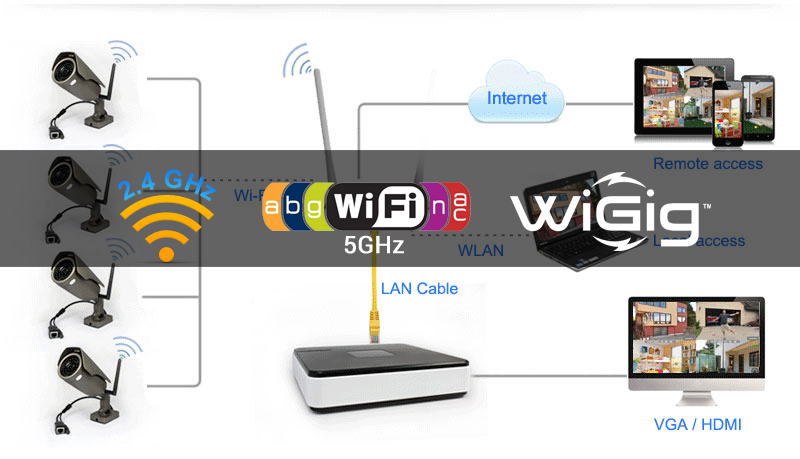
WiFi Network Cameras: 2.4GHz vs 5GHz vs 60GHz
Home users like using the WiFi IP cameras, because there is no Ethernet cable to be used for the network connection. As the IP surveillance solution provider, we often have been asked many questions about the WiFi, e.g. How far can a WiFi signal reach?; 2.4 ghz or 5ghz which is better?; In this article, we intend to offer you these basic knowledge allowing you to find answers.
Yes, the title is not wrong, 60GHz is the next generation WiFi technology after the 802.11 ad, 802.11 ac, it's also called as WiGig. 2.4GHz is the most widely used WiFi band, it includes 802.11 b/g/n standards; 5GHz is another wireless band for dual-band WiFi devices, including 802.11 n/ac standard; 60GHz is the frequency band for next generation 802.11 ad standard. Perhaps many people are inclined to think the new WiFi standard will be better than previous one, 60 > 5 > 2.4, is this true?
Transmission speed
- 2.4GHz: max. 300Mbps transmission speed, this is the maximum data speed what the 802.11n router can achieve when using 2x2 MIMO antenna. Some products claim to support 600Mbps, because under 40Mbps condition, it adds 4x4 MIMO antenna design.
- 5GHz: max. 867Mbps, you can find many dual-band WiFi routers from TP-LINK and Tenda etc manufacturers. Typically these products claim to offer 1167Mbps bandwidth, it's the total bandwidth that has included 300Mbps offered by 2.4GHz band.
- 60Hz: max. 6Gbps, currently you may not find any network devices works on this frequency band, we expect 60GHz WiFi products will appear in the next year.
It's easy to compare the transmission speed data, however there are some differences. 2.4GHz band is the public channel has been widely used by diversity electronics, so interference is particularly serious. If you are in an office building or an apartment, a room will be covered by dozens of different WiFi signals, signal congestion will reduce the network transmission speed. When using 5GHz band, utilizing MIMO technology can double the network bandwidth.
Transmission distance
No accurate data for the transmitting distance of WiFi, we only can find the general data which has been acknowledged by many users. According to the published data by Wikipedia,we find the following approximate WiFi range:
- 2.4GHz: 70m (indoor), 250m (outdoor)
- 5GHz: 35m (indoor)
- 60Ghz: 15m (RF Beamforming, indoor)
According the the "signal attenuation" phenomenon in physics, the higher of frequency, the shorter of signal transmission distance. Like Qualcomm recently launched Snapdragon 810 SoC that supports 802.11 ad standard, 60GHz WiFi signal merely covers a tiny room.
However, the clever engineers invented the "beamforming" technology, to make up a little. Qualcomm's wireless network engineer told us, to the general (2.4GHz, 5GHz) WiFi, the signal will be spread around, so WiFi signal can even cover every corners of the house. The "beamforming" allows the signal concentrated in a certain direction, by increasing the transmit power to ensure that this signal can be transmitted farther.
But the beamforming technology has its limitation, you can't expect the 5GHz/60GHz's transmission distance can exceed 2.4GHz.
In summary, which WiFi signal is fast and good among 2.4GHz, 5GHz, 60GHz? you may have the answer, if you expect a long transmission distance, 2.4GHz can penetrate walls to offer you good signal coverage; if want to use WiFi in commercial building, 5GHz can be your choice. Or, if you live in Kansas City (Google Fiber is available to homes and businesses in select areas of Kansas City), you may contact Qualcomm to try 60GHz WiFi.
Get My Latest Posts
Subscribe to get the latest updates.
Your email address will never be shared with any 3rd parties.